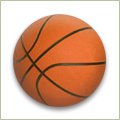 No, this post is not about Coach K, it's about Kay Yow, the legendary women's basketball coach at North Carolina State University. Despite a long battle with breast cancer, she has continued to coach (basketball) and teach (about life) and inspire thousands of others to be not only better players, but better people.
No, this post is not about Coach K, it's about Kay Yow, the legendary women's basketball coach at North Carolina State University. Despite a long battle with breast cancer, she has continued to coach (basketball) and teach (about life) and inspire thousands of others to be not only better players, but better people.In her honor, I've decided to add two more Basketball Charitable Organization Links (on the lower right column of this blog). While not directly involving basketball, these organizations use the power of the game (and the people who love it) to raise funds to fight cancer.
Why focus on cancer? Not only is it predicted to become the leading cause of death in the world by 2010, it's also become very personal to me. At the moment, I'm at the Hospital of the University of Pennsylvania where my father has just underwent surgery for pancreatic cancer, discovered a short while ago.
The diagnosis changes everything - who you are, what you think about. It also clarifies and crystalizes things - like what's important in your life.
While I spend more time thinking about my father's cancer and lending help and support to him and my mother, I'll be spending less time on this blog.
I'll still upload content, but not as much for a while. It gives me pleasure to share my thoughts and to see that, in some small way, I can help others learn important information, so I'm sure I'll get back to blogging more in the future.
In the meantime, don't forget to tell your parents (and anyone else important in your life) that you love them. And consider donating to the V Foundation or to the Kay Yow/WBCA Cancer Fund so that researchers can find more cures, and good people won't be taken too early from this earth.













